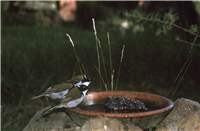Family
Meliphagidae
Genus
Melithreptus
Species
lunatus
Threats/Control Methods - Regional
Feral and domestic Cats (Felis catus) threaten the birds, however the major problem for this species is land clearing. Its regional woodland habitat is being degraded and broken into small areas for agriculture or urban development. Currently it is found in reserves on in areas surrounding the Canberra suburbs that are likely to be developed in future.
Threats/Control Methods - Local
The loss of eucalypt trees from suburban areas may be contributing to the decline of this species in Canberra.
Local/Urban Actions
Cat owners can consider de-sexing their pets and providing a stimulating indoor or enclosed environment for them to enjoy, without the opportunity to hunt. Planting native eucalypts in backyards or participating in tree planting actions through Landcare or Greening Australia will provide more habitats for this species.
Common Names
White-naped Honeyeater, Black-cap, Lunulated or Western Lunulated Honeyeater
Distinguishing Features
This is a medium sized honeyeater at 13-15cm with the typical black downward curved bill. Their black head is made distinct by a white nape towards the back of the head and a bright red, crescent shaped patch above the eye. Its back, wings and tail are olive green and its throat and underbelly is white.
Survey Techniques
Call and visual identification.
Species Call
A loud, musical 'whert-whert', a husky 'shierk' contact call or a clear whistle.
Similar Species
This is the only honeyeater with the red patch above the eye, however it is very similar to the Black-chinned Honeyeater (Melithreptus gularis) and the White-throated Honeyeater (Melithreptus albogularis). The White-eared Honeyeater (Lichenostomus flavus) is also similar, although it has an olive-green instead of white throat and underparts.
Distribution
This species is found along the eastern coastline of mainland Australia across to Adelaide in SA. A small population is also found around the Perth region in WA.
Country of Origin
Australia.
Conservation (Pet/Pest) Status - Regional
Population numbers are known to fluctuate; however the species is declining overall (COG). It is considered rare and sensitive (Freudenberger).
Conservation (Pet/Pest) Status - National
Secure, not listed under the EPBC Act 1999.
LSCCES Population
Medium numbers were found at ANBG and CSIRO, while a few were sighted at BMt and the ANU.
Associated vegetation community
This species resides in eucalypt forest or woodland. It will make its way into more urban areas containing native plants and with forests nearby.
Limiting Resources
The White-naped Honeyeater prefers to forage for food only in the tallest of eucalypt trees, and is found in areas with layers of vegetation, including thick shrubs, logs and ground cover.
Breeding
Breeding occurs in the summer months in communal groups of parents and helpers. The female builds a small, open cup nest in a high tree branch out of grass, bark and a spider web. She incubates the 2-3 light brown eggs for two weeks. The group care for the young in the nest for 15 days, before the process starts again for the second brood. In nesting season, White-eared Honeyeaters are visited by Fan-tailed Cuckoos (Cacomantis flabelliformis), who place an egg in their nest.
Behaviour
The species is almost absent from the Canberra region in the hotter months from November to March, as it migrates into nearby forests to breed. It returns to the city in very high numbers in April, obvious as huge flocks of this species and the Yellow-faced Honeyeater (Lichenostomus chrysops ) fly high above the suburbs. However, it is not always easy to spot, as it spends its time feeding in very tall trees.
Functional Group
Food Species
The White-naped Honeyeater forages in tall trees and underbark, feeding mostly on nectar, but also on insects and insect products like honeydew and lerp or tree sap (manna).
Predators
Domestic Cats (Felis catus) may attack and injure this species. The hatchling of a Fan-tailed Cuckoo (Cacomantis flabelliformis ) will usually push the honeyeater's own eggs out of the nest.
Interesting Fact
Canberra bird-watchers consider the huge flocks of Honeyeaters that return to the Canberra suburbs in April one of the bird highlights of the year.
References - (reader suitability of references, P=Primary teachers, S=Secondary students, T=Tertiary students and researchers)
Books:Freudenberger, D. 2001. Bush for the birds: Biodiversity enhancement guidelines for the Saltshaker Project, Boorowa, NSW. Consultancy report to Greening Australia ACT and SE NSW Inc. CSIRO Sustainable Ecosystems. Canberra. S, T
Longmore, W. 1991. Honeyeaters and their Allies of Australia. CollinsAngus&Robertson Publishers Australia. NSW. P, S, T
Morcombe, M. 2000. Field Guide to Australian Birds. Steve Parish Publishing. Archerfield. Australia P, S, T
Pizzey, G. 2000. The Graham Pizzey & Frank Knight Field Guide to the Birds of Australia. Angus & Robertson, Sydney. P, S, T
Veerman, P. 2003. Canberra Birds: A report on the first 21 years of the garden bird survey. Philip Veerman and Canberra Ornithologists Group. Canberra. S, T
Internet: Birds in Backyards. 2006. [online]. Available at:http://www.birdsinbackyards.net P, S, T
Canberra Ornithological Group (COG). 2004. Birds of Canberra Gardens. COG and the ACT Department of Urban Services. [online]. Available at:http://garden.canberrabirds.org.au/ P, S, T
Online Publications:Nix, H. and Cunningham, R. 2006. Birds of the Lower Sullivans Creek Catchment, Canberra ACT. Prepared for the Life in the Suburbs project using data from the Lower Sullivans Creek Catchment Ecological Survey (LSCCES). Australian National University. Canberra. [online]. Available at: http://www.lifeinthesuburbs.com.au/category.php?id=65 S, T

 Top
Top Top
Top